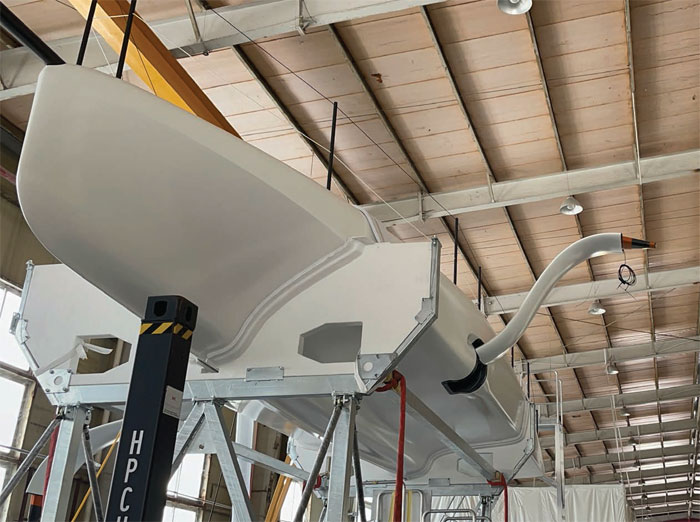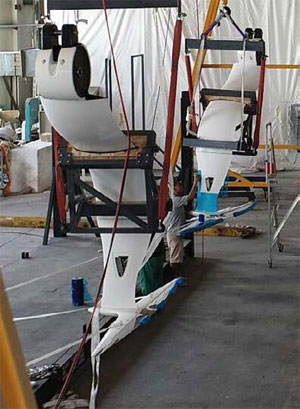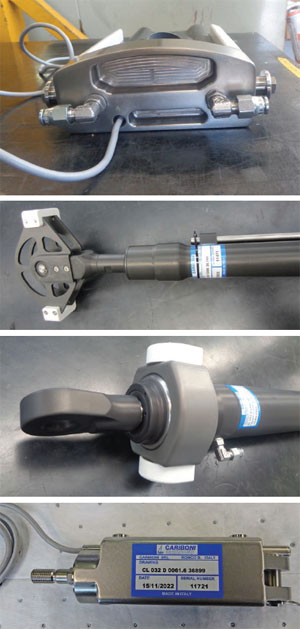

As the foiling AC40 flying monohull flies smoothly across the surface of the water the real magic is happening out of sight below the surface of the water and within the boat itself
Leaving barely any wake and with just a plume of spray streaming off the leeward foil like an airliner’s vapour trail, the impressive straightline speed of the new breed of foiling America’s Cup monohulls seems effortless. Yet, aside from the hardware that you can see, the technology that you can’t see is frequently what makes this all possible. And in this department hydraulics experts Cariboni are at the heart of the new foiling generation.
Among the most recent Cup launches, the AC40 is every bit as impressive as the full blown 75ft Cup boats especially given that the 40’s smaller size and skittish behaviour suggests that effortless flight would be even harder to achieve.
The reality is that this impressive outward performance relies on some very smart trimming to keep the baby-beast on the boil. Trimming both the sails and the foils is tricky enough, but to keep the adjustments in harmony requires the crew to deliver a delicate balancing act on another level.
This in turn has led to some of the most advanced control systems in the high-performance sailing world which has inevitably required equipment manufacturers to push further into new territory.
Among them and at the epicentre of this new-found performance are complex hydraulic systems which, according to Cariboni’s founder Gianni Cariboni, have resulted in some of the most sophisticated systems ever fitted to a raceboat.
‘The number of cylinders alone is a good example as to how much the technology has moved on,’ he says. ‘On an AC40 there are no less than 13 hydraulic cylinders. There is a pair of cylinders each for the canting system, the flap operation and the mainsheet traveller. Then there is a ram for the mainsheet, the jib clew, the jib sheet, the jib cunningham and the jib outhaul. On top of this there are cylinders for the mast rotation and the rudder rake.
‘Clearly, the biggest ram is for the part of the boat with the highest load, the canting foil arm. This is a double acting, all titanium cylinder with bronze spheres that has a pull load pressure of 312bar and a push load pressure of 450bar.

‘The smallest cylinder is for the foil flap which needs to fit within a very tight space. This is a special cylinder, along with the rudder rake cylinder which is also the most complex. These cylinders are square on the outside but round inside and have linear sensors inside so that a very precise amount of movement can be achieved and monitored. The sensor uses a magnet on the inside which means its position can be read on the outside of the cylinder.
‘The rudder rake control is also complex because of the loads involved and the space that’s available,’ he continues. ‘The solution was to use a twin cylinder, but one of the most difficult parts is to machine two completely parallel and identical barrels. The assembly is also pretty tricky.’
But while the intricate double cylinder is one of the most advanced products in the AC40’s hydraulic specification, the underlying concept is not new and was patented by Cariboni some years ago.

‘The idea originated from the need to operate the jumper struts on the old monohull America’s Cup boats,’ says Cariboni. ‘They needed a double chamber to adjust the angle of the struts. Because of the loads involved and the difference small movements would make to the bend characteristics of the mast and hence the power in the sails, the adjustments had to be precise. A double cylinder was the solution. And while the item that the cylinder is adjusting today on the AC40 is a rudder and not the rig, the requirements and underlying principles are just the same.’
But the hydraulic story for the AC40 doesn’t end there. Elsewhere within the design there have been further challenges.
When it comes to the boat’s mainsheet and traveller controls the requirement is for a small-bore cylinder, but up to 2m long. This makes it very difficult to machine because you have to drill it in two parts due to the length. Clearly each operation has to be absolutely precise to achieve an accurate bore.
Aside from building these special cylinders, the speed at which they operate is also an area that is pushing development. The mainsheet traveller is one of the best examples of this as trimming the mainsail while maintaining leach tension and a twist profile means operating at high speeds to maintain the careful balancing act.
A balancing act that demands precise movements, executed at high speed. And it is this frenetic action under the skin of an AC40 that plays such a key part in creating the illusion of simple straight-line speed.
Click here for more information on Cariboni »
We invite you to read on and find out for yourself why Seahorse is the most highly-rated source in the world for anyone who is serious about their racing.
To read on simply SIGN up NOW
Take advantage of our very best subscription offer or order a single copy of this issue of Seahorse.
Online at:
www.seahorse.co.uk/shop and use the code TECH20
Or for iPad simply download the Seahorse App at the iTunes store


